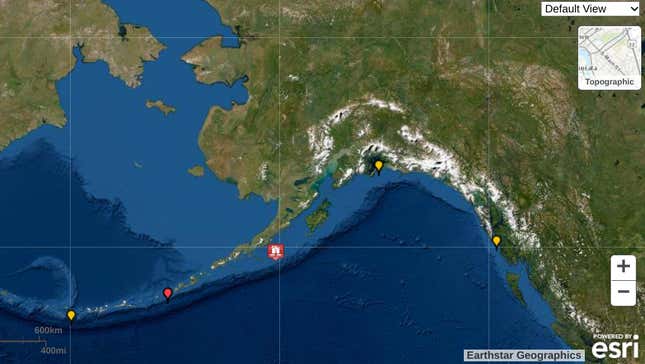
An 8.2 magnitude earthquake struck off the coast of Alaska, roughly 60 miles (97 kilometers) southeast of the town of Chignik, triggering a tsunami warning for large parts of Alaska early Thursday morning, according to the U.S. Tsunami Warning System.
People as far away as Hawaii and New Zealand were also under a tsunami watch after the enormous earthquake, which hit at 10:21 p.m. local time. There are no immediate reports of damage from the earthquake. A few hours after warnings were issued, they were lifted as the threat appears to have passed. New Zealand’s Emergency Management Agency also said the tsunami threat had passed for the island nation, though powerful aftershocks mean that emergency agencies across the Pacific will likely keep an eye on things.
The magnitude 8.2 earthquake, originally reported as an 8.1, occurred roughly 11 miles (18 kilometers) deep, according to the National Tsunami Warning Center in Palmer, Alaska. The agency also warned in a tweet that “Strong & unusual currents may continue for the next several hours” along North American western coast.
As Mike Baker of the New York Times pointed out on Twitter, there have only been 17 earthquakes measuring a magnitude of 8.2 or higher since 1990. Put simply, this is a huge quake. It occurred in the same subduction zone as the second-largest earthquake ever recorded, a magnitude 9.2 rumble that shook the region 1964.
According to the National Weather Service in Anchorage, there was no tsunami threat for the state’s largest city. The city was rocked by a magnitude 7.0 earthquake in 2018.
Earlier this summer, the state also dealt with another kind of quake. Seismometers picked up what was likely an “ice quake” due to extreme heat causing glaciers to melt. Temperatures reached 92 degrees Fahrenheit (33.3 degrees Celsius) in late June amidst the Pacific Northwest heat wave, causing glaciers to shift and crack in ways serious enough to register on seismographs.
Update, 7/29/21, 9:25 a.m.: This post has been updated with new information, including that tsunami warnings have been canceled.